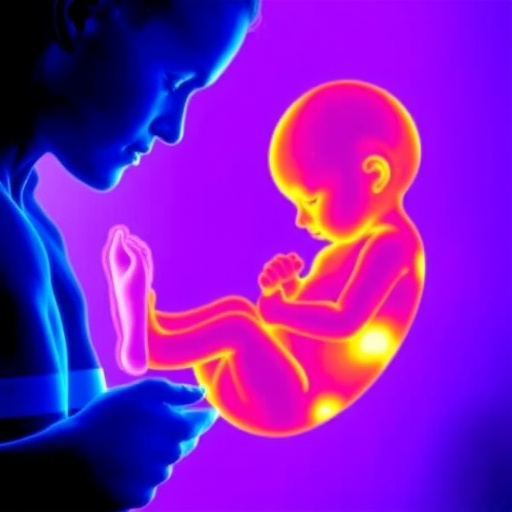In a groundbreaking nationwide study from China, researchers have unveiled compelling evidence linking ambient biothermal stress and preconceptional thyroid function abnormalities to an increased risk of preterm birth. This large-scale investigation, published in Nature Communications, sheds new light on the complex environmental and physiological factors influencing early delivery, a major public health challenge worldwide. Preterm birth, defined as delivery before 37 weeks of gestation, remains a leading cause of neonatal mortality and morbidity, and understanding its multifactorial etiologies is critical for developing preventive strategies.
The study draws attention to the subtle yet significant impact of environmental thermal stress—measured as ambient temperature fluctuations and related biothermal indices—on reproductive health in women planning pregnancy. Prior research has demonstrated that extreme temperatures can jeopardize pregnancy outcomes; however, this investigation bridges the gap by linking temperature exposure with preconceptional thyroid abnormalities. Specifically, the researchers focus on thyrotropin (TSH), a key hormone regulating thyroid activity, whose dysregulation during the periconceptional period appears to predispose pregnant women to adverse birth outcomes.
Utilizing a robust cohort design, the team compiled data from millions of women across diverse climatic regions throughout China. This expansive dataset allowed for comprehensive adjustments for confounders such as socioeconomic status, maternal age, and pre-existing health conditions. By integrating geographic and meteorological data with detailed medical records and thyroid hormone measurements prior to conception, the investigators mapped nuanced relationships that had hitherto been unexplored at this scale.
Their findings reveal that increased ambient biothermal stress, particularly thermal extremes in the weeks preceding conception, was strongly associated with higher levels of TSH abnormalities. Elevated or suppressed TSH levels, indicative of subclinical or overt thyroid dysfunction, correlated positively with the incidence of preterm birth in affected pregnancies. This hormonal disruption suggests that the thyroid gland may act as a biological mediator, translating environmental thermal insult into physiological changes detrimental to fetal development and gestational maintenance.
The implications of these results extend beyond epidemiological interest, proposing a mechanistic link whereby climate factors directly influence endocrine function before pregnancy. The thyroid hormone system is instrumental in metabolism and fetal brain development, and its perturbation during critical reproductive windows may initiate a cascade culminating in premature labor onset. This convergence of environmental and endocrine risks underscores the importance of monitoring thyroid health in women of childbearing age, especially in regions prone to significant temperature variability.
Moreover, the research presents crucial evidence supporting the concept that preconception care must evolve to incorporate environmental exposure assessment. Traditionally, maternal health evaluations emphasize nutritional, genetic, and lifestyle factors; however, this study advocates for integrating climate resilience strategies to mitigate unseen yet impactful thermal stresses. Preventive interventions could involve personalized health counseling, environmental modifications, and targeted thyroid function screenings prior to conception.
The investigators also highlight geographical disparities, noting that women residing in areas with pronounced thermal fluctuations—such as northern and southwestern China—demonstrate heightened susceptibility. These regional differences elucidate the intersection between environmental justice and reproductive health, suggesting that climate adaptation policies should consider vulnerable populations disproportionately affected by biothermal stress.
Methodologically, the study leverages advanced statistical modeling to parse out the interplay between temperature variables and thyroid biomarkers. This approach enables the identification of nonlinear associations and potential threshold effects, enriching the understanding of how incremental changes in biothermal stress translate into measurable hormonal deviations. The use of a nationwide cohort adds robustness and generalizability, addressing limitations of prior localized or retrospective studies.
From a public health perspective, these insights advocate for interdisciplinary collaboration among endocrinologists, climatologists, obstetricians, and policymakers. Such integration is essential for crafting guidelines that factor in environmental determinants of reproductive outcomes. Additionally, it prompts renewed investigation into whether climate change-driven temperature extremes will exacerbate preterm birth rates globally, posing long-term challenges for maternal-fetal medicine.
Importantly, the study calls for further mechanistic research to elucidate the molecular pathways by which thermal stress disrupts thyroid function. Potential avenues include examining oxidative stress, inflammation, and hypothalamic-pituitary-thyroid axis regulation in response to temperature variations. Understanding these pathways will help identify therapeutic targets and refine risk stratification models for adverse pregnancy outcomes.
This comprehensive study stands as a testament to the evolving paradigm recognizing environment-health interconnectivity. It elevates the role of thyroid function as a critical biomarker in the complex web of factors influencing preterm birth and underscores how seemingly indirect exposures, such as ambient temperature, can profoundly affect human reproductive success. The findings portend significant clinical and environmental health implications as societies face the realities of climate change.
In conclusion, this investigation offers pioneering evidence that ambient biothermal stress before pregnancy can induce thyroid hormone abnormalities, which in turn amplify the risk of preterm birth. The nationwide Chinese cohort studied by He, Li, Xu, and their colleagues marks a pivotal step toward unraveling the intricate mechanisms linking climate, endocrine health, and perinatal outcomes. It provides a foundation for innovative prevention strategies aimed at safeguarding maternal and neonatal health amid an era of environmental uncertainty.
As the medical and scientific community continues to delve into the effects of climate on human biology, this study exemplifies how large-scale data integration and interdisciplinary inquiry can yield actionable insights. It urges healthcare systems to anticipate and incorporate environmental variables in reproductive healthcare planning. Ultimately, it champions a holistic approach to maternal health—one that harmonizes environmental stewardship with clinical vigilance to ensure healthier beginnings for future generations.
Subject of Research: The interplay between ambient biothermal stress, preconceptional thyrotropin abnormalities, and preterm birth risk.
Article Title: Ambient biothermal stress, preconceptional thyrotropin abnormalities, and the risk of preterm birth: a nationwide Chinese cohort study.
Article References: He, X., Li, M., Xu, H. et al. Ambient biothermal stress, preconceptional thyrotropin abnormalities, and the risk of preterm birth: a nationwide Chinese cohort study. Nat Commun 16, 9372 (2025). https://doi.org/10.1038/s41467-025-64410-1
Image Credits: AI Generated




